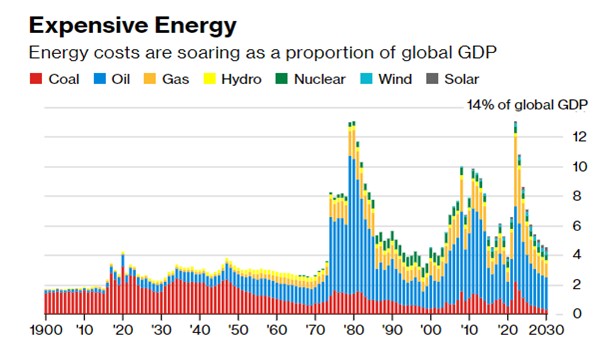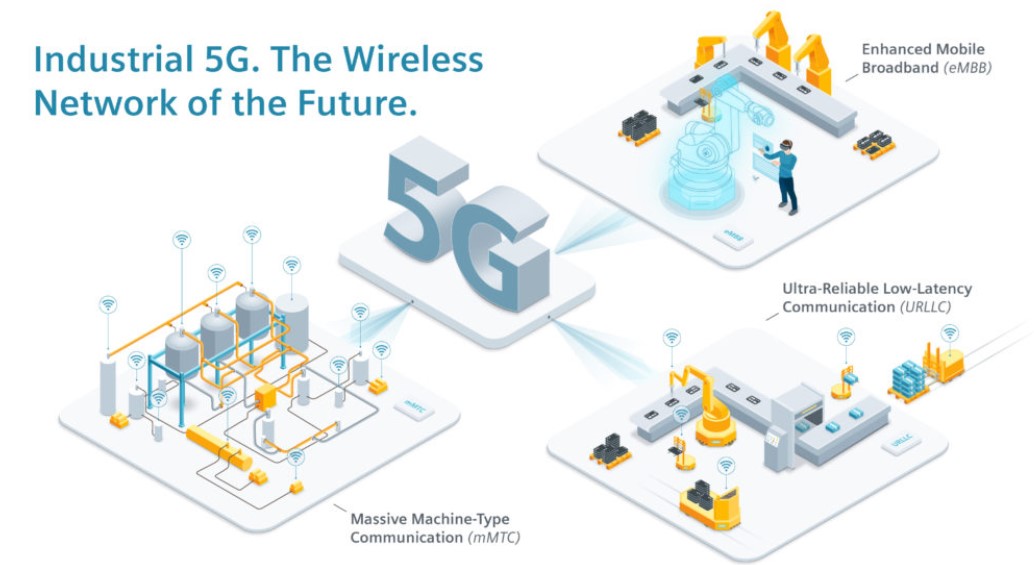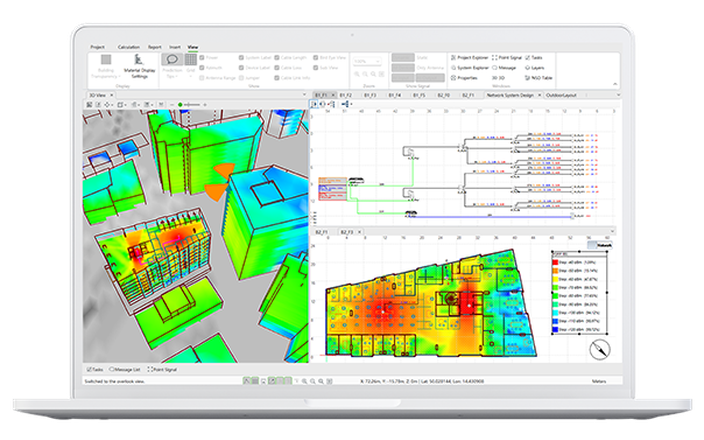
After more than a decade of exceptionally loose monetary policies, progressive expansion of globalization efforts, and a comforting sense of stability and peace, 2022 provided a rude awakening call to business executives and government leaders alike. Now, almost gone is the belief that inflation is all-but-dead, that supply chains are immune to disruption, or that the European continent would be free of military conflicts. In these times, it is more important than ever to remind ourselves of the significance of basic human needs – of which food, protection and the ability to communicate stand out. As one of the most painful and turbulent years in living memory draws to an end, we wish to share our perspectives on how the telecom sector in general and the radio network segment, in particular, may respond to shocks that could persist beyond 2023.
Containing energy costs
Amid surging electricity prices, energy savings have risen to the top of corporate agendas. In recent months, several major Network Operators – especially those within the European Union – have warned of worsening financial results as a direct effect of astonishing increases in their utility bills. To contain the spiralling costs of running their infrastructure - without compromising the users’ service experience - senior executives instinctively turn their attention to efficiency gains. Nowhere is this more crucial than within the radio access network, which typically represents 70-80% of electricity consumption in dense urban areas (where the risks of shortages are the greatest).
 "Energy costs are projected to reach 13% of the global domestic product in 2022, a doubling of its proportionate share in 2021."
"Energy costs are projected to reach 13% of the global domestic product in 2022, a doubling of its proportionate share in 2021."
Source: Thunder Said Energy
Against this backdrop, incentives to modernize equipment, accelerate the shift from 4G to 5G, carefully design new networks or re-design existing ones become ever more compelling. With the help of beamforming, network slicing and a host of AI-inspired technologies, material performance advances and cost savings can be achieved concurrently. The common denominator, as heralded by the popularity of cloud computing, is software which guides and instructs hardware resources to adapt their work in time and space.
According to Ericsson, mobile networks consume 0.6% of the world’s electricity. Whilst this figure may appear insignificant today, it represents an increasingly high burden on Network Operators. It must also be borne in mind that several future applications, such as AR and VR, will be considerably more demanding in terms of computing requirements. In recognition, mobile networks must be planned with the utmost precision, before they are deployed with care and put into operation to meet service level agreements and to contribute to the stated Green-Planet targets. This means, invariably, that planning must go beyond a singular, static mindset. It must take into account predictable and profound variations in traffic loads to ascertain that power-hungry hardware can be put into sleep mode or be turned off without noticeably affecting the integrity or quality of networks. Major indoor venues such as airports, shopping malls, and stadia are prime cases for this kind of operational approach.
Feedback from our customers suggests that cost reductions of not only hardware but also, by extension, electricity (energy) can be achieved by simulating relevant KPIs before the installation of networks.
With the forthcoming arrival of rApps within the world of RICs (Radio Intelligent Controllers) that are instructed to be ‘self-learning’ (from statistical experience), operational effectiveness can be much improved. These advances – which necessitate a much higher degree of openness than in the past – promise to close the gap to realising self-organizing networks, which has long eluded the wireless sector.
In 2023, we expect that energy performance will feature prominently in virtually all major investment decisions. In so doing, decision-makers pave the way for lessening reliance on external sources of coal, gas and oil, whilst, importantly, contributing positively to helping the world reach its net zero CO2 ambitions.
Public Safety powered by 5G
In a world marked by heightened uncertainties, geopolitical tension and recurring shocks (such as natural disasters, global pandemics or terror attacks), authorities are bound to put much more emphasis on securing functional and resilient communication for mission-critical services. In 2023 and beyond, we envisage a number of high-profile public safety programs to be announced, not least within the European Union – shaken by the eruption of a full-scale war on its doorstep - which has yet to embrace initiatives already seen in North America (FirstNet) and elsewhere. To ensure maximal capability, cost-efficiency, quality and serviceability, 5G technology is set to replace a contingent of legacy systems, dominated by TETRA which was first introduced in the mid-1990s.
In shifting from a low-frequency TDMA-based system to a layered ODFMA architecture – catering to a sea-change in capacity requirements in the age of videos - Network Operators will be required to completely revamp their networks while ascertaining that redundancy, in the event of failures, is incorporated from day one. Extreme levels of security through advanced levels of encryption, rapid deployment networks (and recoveries of those which go down) as well as support for one-to-one, one-to-many and many-to-many communication constitute other central ingredients.
Dynamic resource allocation in space and time
Network slicing, the means through which network resources can be re-allocated dynamically and flexibly in space and time, preferably on an end-to-end basis, was all the rage during the embryonic days of the 5G cycle. In recent years, it seems to have given way to Enterprise Cellular – often entirely new networks devoted to the needs and wants of organisations (whether private or public). Yet, one concept does not exclude the other. In many scenarios, not least where users hop between networks for mundane services such as mobile broadband, slicing makes a whole lot of sense. While the spatial dimension in predictably crowded places, notably airports and shopping malls, poses material challenges, it is entirely manageable in controlled environments, such as factory floors, warehouses or sports venues (as always, it is prudent to commence a learning curve with the easiest, not the most demanding, of use cases).
Ranplan Wireless strives to contribute richly to these developments. By the middle of 2024, Ranplan is scheduled to complete an EU-horizon funded (EUR 1.4 million) project, known as BANYAN which is dedicated to AI-powered data-driven network planning and/or optimisation for 5G radio access networks. As the Project’s Lead Partner, Ranplan has developed a deep-neural-network-based data-driven radio propagation model, known as DeepRay, which can mimic a ray-tracer, demonstrating a similar accuracy of path loss calculation but returning results in a matter of milliseconds rather than minutes or hours.
 Source: Deutsche Telekom
Source: Deutsche Telekom
Private Wireless fuels extra impetus
Although difficult economic conditions, triggered by steeper capital costs and noticeably heightened risk aversion, are bound to weaken inclinations to consume and invest, the benefits and virtues of deploying 5G for a host of new applications, not least within the industrial/manufacturing domain, will remain in place for 2023.
Private Wireless, closely associated with 5G and fuelled by a whole roster of fascinating, novel services, still provides the most compelling of reasons to take the art of mobile connectivity to an entirely new level. By enabling the smart factory, the fully automated warehouse or the remotely controlled machinery, enterprises can attain efficiency gains on an unparalleled scale. By taking advantage of the enhanced capabilities of 5G, cameras – whether for inspection and maintenance of equipment or processes, or monitoring/surveillance of critical events, special incidents or protected places, enterprises and authorities can greatly advance their missions in terms of operating efficiency and public safety. But a prerequisite to even consider replacing a cabled (wired) setting is that all requirements associated with latency (responsiveness to requested data transfer), reliability (consistency in performance), and security (free from potential harm caused by others) are met.
To this end, careful planning with the assistance of state-of-the-art simulation tools which provide an accurate replica of the real world, allow for the evaluation of all relevant key performance metrics (including latency and speed), and handle either side of the walls (floors and ceilings) of buildings as one unity, are indispensable.

Source: Siemens.
Industrial Applications leading the charge
Experience drawn from China, Japan and increasingly also South Korea serves to underpin the business case for 5G-powered industrial applications. Germany, the heartland of manufacturing prowess within Europe, seems poised to follow suit. In the USA, where the CBRS bandwagon hitherto has been chiefly focused on the outdoor space, attention is shifting towards much more demanding campus-style designs – necessitating a holistic approach to mastering the indoor and the outdoor environment in harmony. In the era of enterprise cellular – dedicated to the specific needs and wants of a well-defined group, it is imperative that public networks – catering to all types of users with the help of licensed (purchased) spectrum – not be impaired. To this end, negative interferences between the private and the public domains must be minimized in an accurate, controlled and predictable manner.
Latency and redundancy enter the stage
New situations tend to require new solutions. To ascertain that factories, warehouses and mines can be run absolutely reliably with the assistance of wireless connections (5G, Wi-Fi 6 or any combination thereof, or their successor technology generations), enterprises must ascertain that latency and redundancy requirements are met. These factors add further complexity to the design planning and optimization process, lending further credence to the view that the days of ad hoc (trial and error) deployments of mobile networks must be considered a thing of the past. It is much more prudent and shrewder – from both an economic/financial and operational perspective – to ‘think carefully before you act’. The performance and resilience of most wireless networks dedicated to critical operations – the failures of which are very costly – must be thoroughly evaluated from the focal lenses of a series of ‘what-if-this-were-to-happen’ scenarios prior to deployment.
5T: Total Transformative Transitions Take Time
Although all the visions associated with 5G have yet to be realized, it should not dampen enthusiasm as to the lasting benefits this technology generation can engender. This applies not least to the plethora of entirely new specialized applications associated with private wireless and public safety. Total transformative transitions, after all, take time as experienced from previous generation shifts such as 3G/WCMDA over 20 years ago. At this juncture, a much broader and deeper ecosystem of companies – encompassing not only traditional telecom players but also the leading names of the IT sector (including web-scale giants) - must come together. In 2023, we anticipate solid progress in terms of convincing POCs (Proofs of Concepts), field trials, Cloud-Native transformations and provision of devices in support of the high-band frequencies.
Centralise what you can - distribute what you must
The sheer complexity of 5G and the diversity of use cases call for a centralization of the provision and management of services and security (yet, needless to state, antennas representing the point of access to an interconnecting network have to be distributed almost irrespective of technology and/or type of application). As a corollary, the decoupling of software from hardware is poised to continue to win terrain. To this end, openness, in the practical sense of the word, is imperative. In its absence, the cost of data conversion, system integration and supplier coordination may be prohibitively high. We envisage that leading protagonists of the mobile industry will learn from the experience of costly and tedious efforts to fully standardize all interfaces within the RAN (Radio Access Network). The variety of RICs that have been proposed, at least a dozen according to Fierce Wireless and other commentators, suggests that a more pragmatic approach – one resembling that of V-RANs (involving only a select few vendors) – could gather steam. We expect a re-think in 2023 and beyond, one which resets expectations and seeks to pick the ‘low-hanging fruits’. One of the few advantages of a harsher economic climate, after all, is that such an ambience tends to sharpen people’s minds, allowing them to focus on what makes absolute sense, give up what does not and hence prune activities of lesser importance.
Digital Reality powered by AI/ML and standards like BIM
If there is one area where the telecom industry lags far behind its IT peers, then the concept of the Metaverse, also known as Digital Twins or perhaps more appropriately Digital Realities (akin to Augmented and Virtual Realities which bear quite a semblance) certainly stands out. The establishment of a common BIM standard (there are already too many variants) would be critical to enabling the automation of operations with the help of closed RAN loops:
- Extraction of information from network nodes and devices,
- Simulation of possible changes to the use of network resources,
- Re-configuration of network nodes provided that (2) meet the evaluation criteria.
We expect and hope that the industry will advance work on this topic in 2023.
Simulating wireless performance on a digital replica of an oil rig

Significance of connectivity for economic and social welfare
In a final remark, we wish to stress that external shocks in recent years serve to illustrate the importance of connectivity for the economic and social welfare of human beings. While far from immune to the effects of an economic downturn, investments in network equipment, professional services and ancillary software tools are likely to hold up well in 2023 (and increase their share of the GDP in most regions). In spite of the swelling cost of capital, we would not be surprised in the slightest if a number of major initiatives will soon be announced by early adopters of private wireless (keen to exploit 5G to attain and sustain a competitive edge), public safety authorities (anxious to build resilience and resistance to cyber-attacks) and officials of emerging markets (inspired perhaps by India which received lots of attention last autumn with its exceedingly ambitious plan to deploy millions of state-of-the-art 5G massive MIMO base stations).




